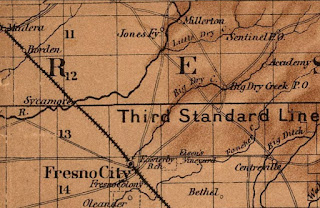The Pollasky Bridge near modern day Friant is a ruined highway bridge which was completed during early 1906 as part of the Fresno-Fresno Flats Road. The structure is one of the oldest known arch concrete spans to have been constructed in California. The bridge briefly carried California State Route 41 following the destruction of the Lanes Bridge in 1940. The Pollasky Bridge itself was destroyed by flooding during 1951, but the ruins can still be found on the Madera County side of the San Joaquin River.
Pictured as the blog cover is the Pollasky Bridge as it was featured in the 1913 book "The Concrete Bridge." The structure can be seen crossing the San Joaquin River near Friant below on the 1922 United States Geological Survey Map.
Part 1; the history of the Pollasky Bridge
The Pollasky Bridge site is near modern day Friant of Fresno County. The community of Friant was established as Converse Ferry during 1852 on the San Joaquin River downstream Fort Miller and the community of Millerton. Upon the formation of the Stockton-Los Angeles Road, Millerton-Fresno Flats Road and Crane Valley Road the site of Converse Ferry would become increasingly important as a crossing of the San Joaquin River. During 1863 Converse Ferry changed hands would be renamed as "Jones Ferry."
Jones Ferry can be seen south of Millerton along the Fresno-Fresno Flats Road on the 1882 Bancroft's Map of California. Note: Jones Ferry was renamed to "Hamptonville" during 1881, but it was not captured on the 1882 Bancroft's Map.
Hamptonville and the road to Fresno can be seen on the 1891Thompson Map of Fresno County. Note: during 1891 the community of Hamptonville would be renamed to "Pollasky" after the community received railroad service. Pollasky was a reference to Southern Pacific Railroad official Marcus Pollasky.
The Pollasky Bridge was billed as a potential major project by W.A. Ellis leading the Madera County Surveyor election of 1902. The structure was formally surveyed in 1903 and broke ground during 1905. The ferry crossing at Pollasky would be replaced by a new concrete bridge which opened to traffic on January 7, 1906. The new concrete bridge connected Pollasky directly to the Fresno-Fresno Flats Road (now Road 206) in Madera County. The Pollasky Bridge can be seen in a photo from the 1913 book "
The Concrete Bridge." Note: Pollasky would assume the modern community's name of "Friant" during 1907. The name "Friant" is a reference to local lumber company executive Thomas Friant.

Friant, Friant Road and the Pollasky Bridge can all be seen on the 1914 Weber Map of Fresno County.
Friant Road from Herndon Avenue/Blackstone Avenue near Pinedale to Lanes Road was added to the State Highway System during 1933 (legislative chapter 767) as a component of Legislative Route Number 125. The same portion of Friant Road would be assigned as California State Route 41 when the initial run of Sign State Routes was announced in August 1934 California Highways & Public Works.
California State Route 41 can be seen following Friant Road from Herndon Avenue/Blackstone Avenue to Lanes Road on the
1935 Division of Highways Map of Fresno County. California State Route 41 and Legislative Route Number 125 are shown crossing the San Joaquin River into Madera County via the 1889 Lanes Bridge.

The 1889 Lanes Bridge was partially destroyed by an overloaded truck collapsing the road deck during 1940. California State Route 41 was realigned onto a temporary detour north of Lanes Road via Friant Road to Friant and the Pollasky Bridge over the San Joaquin River. The
August 1940 California Highways & Public Works announced awarded contracts to construct a new Lanes Bridge along with other structures as an extension of Blackstone Avenue.
The
November 1941 California Highways & Public Works featured the opening of the new Lanes Bridge and realignment of California State Route 41 via the Blackstone Avenue extension. The new Lanes Bridge was dedicated and open to traffic on October 12, 1941. The realignment of California State Route 41 onto the new Lanes Bridge took the Pollasky Bridge out of the State Highway System. The detour alignment of California State Route 41 to Friant via Friant Road and Pollasky Bridge is described as having been five miles longer than the new highway.
Despite Friant Dam being completed during 1942 the waters below the structure at Friant became too strong during 1951 and destroyed the Pollasky Bridge. During 1952 a replacement bridge over San Joaquin River was constructed.
Part 2; a visit to the Pollasky Bridge
The 1952 North Fork Road Bridge still spans the San Joaquin River below Friant Dam.
The ruins of the 1906 North Fork Road Bridge were never removed from the Madera County side of the San Joaquin River and can be easily observed south of the 1952 replacement span.



















Comments